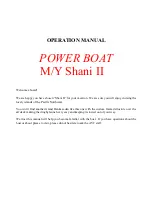
Make sure that the oil tanks are well stocked with the type of engine oil that is recommended for your
engines. Refer to your engine manual. It is imperative that the oil supply remains clean and
uncontaminated by water or dirt. Check to make sure the oil lines are free from leaks, kinks and chafing.
Some motors use a primer bulb to initiate oil flow. Air may periodically enter the system and require
purging. Refer to your engine manual for specific instructions.
If your optional engine package requires the installation of remote oil tanks, please refer to the owner’s
manual provided by the engine manufacturer for operational procedures and for information related to the
care and maintenance of their product. When in doubt, always defer to the engine manufacturer’s
instructions and/or recommendations.
Fuel / Oil Leaks
The fuel tank is vented overboard and the vent should be inspected for obstructions regularly. Ensure all
of the fuel hoses remain properly secured and located according to NMMA standards. Inspect all hose
clamps and fittings to ensure they are double clamped where needed and that there are no fuel leaks in
any of the hoses. Also, inspect the oil system, if applicable, and ensure that the oil tank and hoses
remain properly connected and secured.
If you notice a fuel odor or see fuel in the bilge, there may be a leak somewhere in the fuel system.
Correct any fuel leaks before operating the vessel.
Caution: If at all possible
, any fuel tank and or fuel system repair should be handled by
your dealer’s service department or by another qualified professional.
Cabin Appliances and Accessories
Your galley comes equipped with an alcohol/electric stove, microwave and a direct current refrigerator. In
addition, the optional electronics equipment listed below is available for installation in the main cabin:
•
Stereo - AM/FM CD with 4 Speakers and Remote
•
Stereo - AM/FM CD with Upgraded Speakers, Woofer & Amplifier
•
Stereo - XM Upgrade
•
Television (Flat Screen) w/DVD Player (includes Cable Outlet)
Please refer to the owner’s manuals provided by the manufacturers of the components listed in this
section for operational procedures and for information related to the care and maintenance of their
products. When in doubt, always defer to the component manufacturer’s instructions and/or
recommendations.
Note: The individual manufacturers of each of the following products listed in this section
provide the limited warranties for their equipment and most associated parts. Each
manufacturer provides recommendations regarding service and warranty related issues.
In many cases, service and/or warranty repairs must be performed by a repair facility that
is authorized to work on their equipment.
Refrigerator
The DC refrigerator is located in the galley. There is a latch located on the left side of the refrigerator
door that secures the door. To open the refrigerator door, slide the latch to the left. Slide the latch back
to the right to hold the door securely in place when the door is closed.
To operate the refrigerator, locate the refrigerator and DC main switches on the AC/DC panel inside the
cabin and turn both switches on. The control knob located inside the refrigerator allows you to set the
refrigerator at the desired temperature level. When you are not using the appliance, all switches should
be in the off position.
41
















































